Abstract
Cement is the most widely used construction material in the world. However, its manufacture is high energy consumption and high carbon emission owing to the high temperature calcination process. Geopolymer is an ideal alternative material for cement because it has a similar structure and performance to cement. In addition, it can be synthesized at room temperature and thus has the advantages of energy saving and carbon emission reduction. Sewage sludge (SS) can be used as raw material for geopolymer synthesis. However, the high organic matter content in SS lowers the mechanical strength of geopolymer. Although the organic matter in SS can be removed by incineration at high temperature, this consumes energy and emits carbon dioxide, which diminishes the advantages of geopolymer. In this study, the Fenton method was applied for the removal of organic matter in SS at room temperature. The parameters of the Fenton method, including the dosages of hydrogen peroxide (H2O2) and Fe2+ reagent (FeSO4·7H2O), reaction time, and initial pH value, were investigated. The results indicated that 83.7% of the organic matter in SS could be removed at room temperature by using 5.15 M H2O2 and 5.15 mM FeSO4·7H2O at pH 7, which suggested the possibility of sewage sludge reclamation through geopolymer synthesis as an alternative material for cement toward sustainability.
1. Introduction
Cement is made from limestone, clay, silica sand, and iron slag. They are ground and mixed with appropriate ingredients, followed by sintering in a rotary kiln at high temperature to become clinker, which is then ground with an appropriate amount of gypsum. Cement is the most widely used construction materials in the world. However, the production and processing of cement consume a high amount energy and cause high carbon dioxide emissions [1].
Geopolymer is thought of as an ideal alternative material for cement because it has a similar structure and performance to cement. In addition, it can be synthesized at room temperature and thus has the advantages of energy saving and carbon emission reduction. Geopolymer can be synthesized by solid wastes containing silicon and aluminum, such as fly ash, slag, sewage sludge (SS), etc. [2]. Through the activation by a strong alkali, it is possible to form a structure that is chemically and structurally similar to cement. In addition, geopolymer can solidify heavy metals and thus is an environmentally friendly building material. Generally, raw materials containing high contents of silicon (Si) and aluminum (Al) can be used for the synthesis of geopolymer, such as blast furnace stone powder [3], met-kaolin and volcanic ash [4], coal-fired fly ash [5], and reservoir sludge [6].
On the other hand, sewage sludge (SS) also has high contents of Si and Al and thus can also be used as a raw material for geopolymer synthesis. However, the high organic matter content in SS lowers the mechanical strength of the synthesized geopolymer. Several treatment methods have been researched to remove the organic matter in SS, including anaerobic digestion, gasification, pyrolysis, supercritical water processing, and incineration [7,8]. Recently, the removal of organic matter in SS is mainly treated by incineration due to its convenience. However, the incineration method usually needs to be carried out at a high temperature of 1000 °C, which consumes much energy and emits large amounts of carbon dioxide, thus diminishing the advantages of geopolymer. For the sustainable reclamation of SS as a raw material of geopolymer, the removal of organic matter in SS at room temperature is required.
The Fenton method has been widely investigated for the treatment of organic wastewater streams such as textiles [9,10], pharmaceuticals [11,12], olive mill [13,14], leachate [15], agrochemicals [16,17], etc. In addition, the Fenton method has also been proposed as an environmental friendly approach for the conditioning, dewatering, and filtration of SS. Neyens et al. claimed that at an initial pH value of 3, and with the dosages of 1.67 mg Fe2+/g dry solid (DS) and 25 mg H2O2/g DS, the water content of SS can be reduced to 47%, considering Fenton’s reagent (H2O2 and Fe2+) as a chemical conditioner for SS [18]. The Fenton reaction was also proposed to enhance the SS cake dewaterability through the mechanism of degrading extracellular polymeric substances (EPS) which contained a large amount of water [19]. Lu et al. reported that within the initial pH value range from 2 to 7, the Fenton reaction appeared to have insignificant effects on filtration efficiency and had a minor effect on the moisture of SS cake [20]. Tony et al. reported that under the conditions of Fe2+/H2O2 = 20/125 mg/g DS and pH 6, the considerable effectiveness of the highest reduction efficiency of capillary suction time (CST) could be achieved [21]. Liu et al. reported that under the optimal conditions of pH 5, Fe2+ = 40 mg/g DS, H2O2 = 32 mg/g DS, a specific resistant to filtration reduction efficiency of 95% was achieved in the process of applying SS as the skeleton builder [22]. Liu et al. and Hu et al. both combined Fenton’s reagent and lime for the conditioning of SS [23,24]. Yu et al. reported less necessity of initial acidification of Fenton conditioning and the pH of the final filtrate was 6.6 ± 0.2 [24]. Most of the previous studies on wastewater treatment emphasized the initial pH should be an important parameter. However, they did not make a consistent conclusion on the optimal initial pH value in SS conditioning using Fenton’s reagents. Regarding the issue of hazardous waste in SS, Dewil et al. proposed that alkaline thermal hydrolysis and Fenton’s peroxidation can reduce the heavy metal content of waste activated sludge by degrading the EPS. A significant reduction on several heavy metals was confirmed [25]. Zhu et al. also reported that combined bioleaching and Fenton-like reaction using the catalyst of Fe2+ by iron-oxidized bacteria and an optimal H2O2 dosage of 5 g/L, the removal of Cu, Zn, Pb, and Cd reached 75.3%, 72.6%, 34.5%, and 65.4%, respectively [26]. In addition, Wen et al. reported that at an initial pH of 2.5–3.0, a molar ratio of Fe2+/H2O2 = 0.1 ~ 0.4, and a H2O2 dosage of 20 mmol/L, a radical-induced SS Fe nanoparticles (Fe NPs) was made to be the catalyst to degrade the Black-T in textile [27]. Previous studies basically worked on the issue of SS conditioning, SS dewatering and heavy metal reduction in SS by Fenton’s reagent. However, the application of the Fenton method for the removal of organic matter in SS has seldom been investigated.
In the present work, the feasibility of removing organic matter in SS at room temperature through the Fenton method was investigated. The effect of operational parameters, including the concentration and ratio of Fenton’s reagent, initial pH value, reaction time [28], on the removal of organic matter in SS was proposed.
2. Materials and Methods
2.1. Materials
A SS sample (TS = 3124 mg/L, VSS = 2480 mg/L) obtained from the Dihua Sewage Treatment Plant in Taipei City, Taiwan was used in this study. The as-received SS sample was dewatered by a belt press dehydrator and dried by an indirect heating dryer at 105 °C in the SS treatment unit of this treatment plant for the purpose of reducing the volume of the produced SS. The main elements in the as-received SS sample are shown in Table 1 which was determined by using X-ray fluorescence spectroscopy (XRF) (SEA6000VX, TechMax). Hydrogen peroxide solution (H2O2, 35 wt %) (MERU Ltd., Taiwan) and ferrous sulfate (FeSO4·7H2O) (J.T Baker, USA) were used in Fenton experiments.

Table 1.
Main elements in the as-received sewage sludge (SS) sample.
2.2. Methods
The SS sample was first dried in an oven at 105 °C for 24 h. After drying, 5 g SS was put into a 1000 ml beaker and mixed with 200 ml distilled water and then stirred with a magnetic mixer for 1 h. The initial pH was adjusted to the decided value with 0.1 M hydrochloric acid (HCl) and 0.1 M sodium hydroxide (NaOH). The detailed operating procedure of the Fenton method was described in a number of researches [29,30,31] and the equations are shown in Equations (1)–(3). After adding FeSO4·7H2O as catalyst and stirred in a magnetic mixer for 15 mins, H2O2 was added to activate the reaction. The experimental pH range was 3, 5, 7, 8, 9. The H2O2 dosages of 1.03 M, 2.06 M, 3.09 M, 4.12 M, and 5.15 M, the Fe2+ dosages of 1.72 mM, 2.06 mM, 2.58 mM, 3.43 mM, and 5.15 mM, the [H2O2]/[Fe2+] molar ratios of 1000, 1500, 2000, 2500, and 3000, and the reaction time of 0.5 h, 1 h, 2 h, 4 h, 8 h, 24 h, and 48 h were tested. After the reaction was completed, the solid-liquid separation was conducted using a centrifuge (Tabletop Centrifuge Model 4000, KUBOTA Corp, Japan) at 3500 rpm for 10 mins. The solid fraction was dried in an oven at 105 °C for 24 h to determine the moisture content. The metal contents in the solid fraction after being dissolved by aqua regia as well as in the liquid fraction were quantitatively analyzed by Induced Coupled Plasma–Optical Emission Spectrometer (ICP-OES, Optima 8300, Perkin Elmer, USA). The thermogravimetric analysis of SS was determined by Thermogravimetry/Differential Thermal Analyzer [32] (TG/DTA) (HITACHI, STA7300, Japan). The heating and combustion treatments were carried out in a muffle furnace (KO TSAO Ltd., Taiwan). The H2O2 concentration was analyzed by colorimetric determination [33] with a potassium permanganate redox titration method [34] between 470–520 nm using a spectrophotometer (DR-4000, HACH, USA). Each experiment in this study was performed at least three replicates. The mean value and standard deviation were calculated and plotted.
Fe2+ + H2O2 → Fe3+ + HO• + OH−
Fe3+ + H2O2 → Fe2+ + HOO• + H+
2H2O2 → HO• + HOO• + H2O
3. Results
Initially, the TG/DTA analysis was applied to determine the thermal characteristics of SS. The results are shown in Figure 1. With the increase of temperature, the weight of SS gradually decreased. In addition, the strongest exothermic peak appeared at about to 600 °C. Therefore, 600 °C was chosen as the temperature to determine the removal of organic matter in SS. In the Fenton experiments, a single-factor experiment was firstly applied to obtain the optimal reaction time. Then, an experimental design was applied to evaluate the effects of the other four variables (initial pH, Fe2+, H2O2, [H2O2]/[Fe2+]), as shown in Table 2.
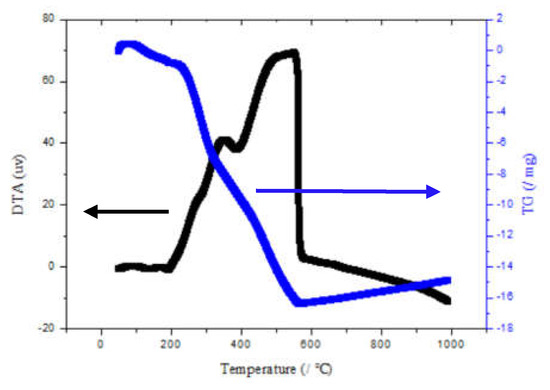
Figure 1.
Thermogravimetry/differential thermal analyzer TG/DTA analysis of SS.

Table 2.
Factors and levels of the experimental design.
3.1. The Effect of Initial pH Value
The effect of initial pH value on the removal of organic matter is shown in Figure 2. Under the experimental conditions of a fixed molar ratio [H2O2]/[Fe2+] of 1000 and variable H2O2 concentrations, the removal of organic matter increased with the increase in initial pH value from pH 3–7. A maximum removal of 79.1% was obtained at pH 7 with the dosage of 5.15 M H2O2. The data are also presented in Table 3. By contrast, it was observed that at pH values of 8 and 9, the effectiveness of pH on the removal fraction gradually decreased with the increase in H2O2 concentration. Consequently, the optimal initial pH value was considered to be pH 7.
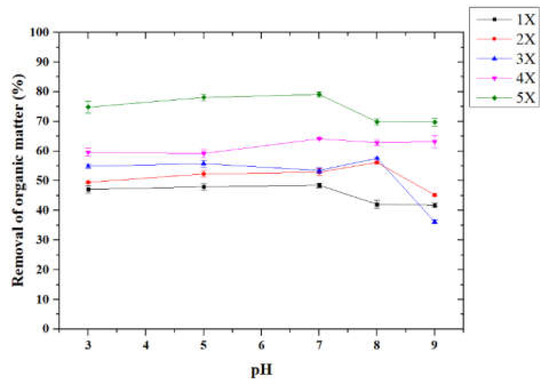
Figure 2.
The effect of initial pH value on the removal of organic matter (Experimental conditions: 1X ~ 5X indicate the dosage of H2O2 from 1.03 M ~ 5.15 M, molar ratio [H2O2]/[Fe2+] of 1000, reaction time of 3 h, 5 g SS in 200 ml distilled water).

Table 3.
The removal of organic matter at different initial pH values and H2O2 dosages.
3.2. The Effect of H2O2 Dosage
The effect of H2O2 dosage on the removal of organic matter and the organic/inorganic fraction is shown in Figure 3. With the increase in H2O2 dosage, the removal of organic matter increased. In addition, the organic fraction decreased whereas the inorganic fraction increased, which implied the removal of organic matter. When the H2O2 dosage was higher than 4.12 M, the removal of organic matter and the organic/inorganic fraction had no significant change. The removal of organic matter reached 29.5% when the H2O2 dosage was 5.15 M. In addition, the organic and inorganic fraction were almost the same (50.4% and 49.6%, respectively).
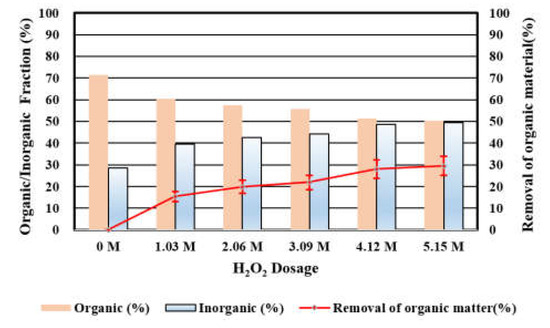
Figure 3.
The effect of H2O2 dosage on the removal of organic matter and the organic/inorganic fraction (Experimental conditions: the dosage of H2O2 was prepared by diluting the 35 wt % H2O2 solution, reaction time of 3 h, pH 7, 5 g SS in 200 ml distilled water).
3.3. The Effect of [H2O2]/[Fe2+] Molar Ratio
The effect of [H2O2]/[Fe2+] molar ratio on the removal of organic matter and the organic/inorganic fraction is shown in Figure 4. When the H2O2 dosage was fixed at 5.15 M, the removal of organic matter increased with the decrease in [H2O2]/[Fe2+] molar ratio from 3000 to 1000. In addition, the organic fraction decreased whereas the inorganic fraction increased, which implied the removal of organic matter. The removal of organic matter achieved 77.2% when the Fe2+ dosage was 5.15 mM and the [H2O2]/[Fe2+] molar ratio was 1000. Meanwhile, the organic and inorganic fraction was 16.3% and 83.7%, respectively. The difference between the organic and inorganic fraction reached a maximum level.
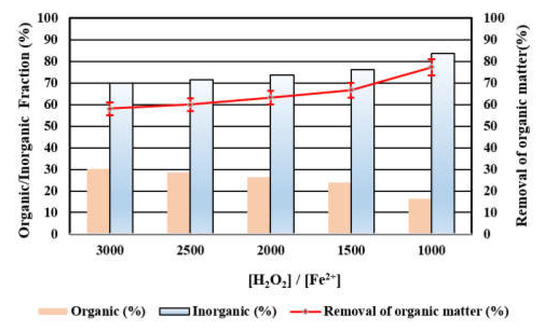
Figure 4.
The effect of [H2O2]/[Fe2+] molar ratio on the removal of organic matter and the organic/inorganic fraction (Experimental conditions: the dosage of H2O2 was fixed at 5.15 M, the dosage of Fe2+ was 1.72–5.15 mM, reaction time of 3 h, pH 7, 5 g SS in 200 ml distilled water).
3.4. The Effect of Reaction Time
The effect of reaction time on the removal of organic matter is shown in Figure 5. With the dosages of 5.15 M H2O2 and 5.15 mM Fe2+ at pH 7, the removal of organic matter increased with reaction time until 2 h. There is no significant change in the removal of organic matter after 2 h. The maximum removal of organic matter 83.7% was reached at 2 h.
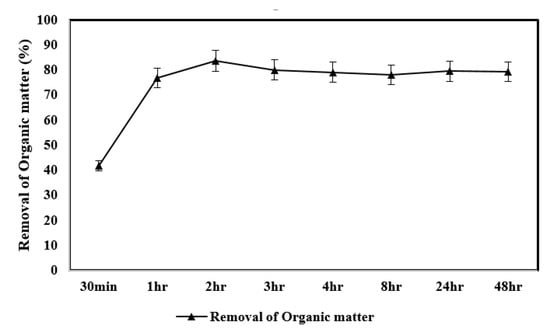
Figure 5.
The effect of reaction time on the removal of organic matter (Experimental conditions: H2O2 dosage 5.15 M, Fe2+ dosage 5.15 mM, pH 7, 5 g SS in 200 ml distilled water).
3.5. The Hevay Metal Content in the Solid Fraction after Fenton Treatment
According to the above experimental results, the optimal conditions for the removal of organic matter in SS by the Fenton method were H2O2 dosage of 5.15 M, Fe2+ dosage of 5.15 mM, reaction time of 2 h, and pH 7. Under these conditions, the maximum organic matter removal of 83.7% was obtained. On the other hand, the heavy metal content in the solid fraction obtained from the aforementioned optimal Fenton treatment conditions is shown in Table 4. The main heavy metal elements in the SS after Fenton treatment were Si (18.4 wt %) and Al (39.4 wt %), which was suitable to be an ideal raw material for the synthesis of geopolymer. On the other hand, Zhu et al. reported that 75.3% of Cu in SS was removed after Fenton treatment [26]. In this work, the removal of Cu in SS was 79.1%, which was similar to Zhu et al.’s result. The effectiveness of heavy metal reduction in SS after Fenton treatment was also confirmed.

Table 4.
The hevay metal content in the solid fraction after Fenton treatment (X-ray fluorescence spectroscopy (XRF) values) (Experimental conditions: H2O2 dosage 5.15 M, Fe2+ dosage 5.15 mM, pH 7, 5 g SS in 200 ml distilled water).
4. Discussion
In this section, several parameters involved in Fenton reaction, including the initial pH value, molar ratio of Fenton’s reagent ([Fe2+]/[H2O2]), reaction time, heavy metal reduction, and organic matter removal were discussed.
According to the theory of Fenton reaction [35], an increase in pH not only inhibits the production of OH· radical, but also causes the precipitation of Fe2+ in the solution which loses the catalytic ability of Fe2+. Generally, Fenton reaction has a high degradation efficiency at an initial pH of 3 in wastewater treatment. Different from wastewater treatment, however, it is reported that the initial pH value within 2–7 has no significant effect on the efficiency of oxidation when applying Fenton treatment for SS [20,21,22]. In this work, a phenomenon was observed that no matter what the initial pH values were within pH 3–9, the final pH values after Fenton treatment were almost within pH 1–2. It might be caused by the decomposition of the long-chain organic matter by the OH· radical, which released the short-chain organic acid and thus lowered the final pH values. Therefore, the initial pH value has no significant effect on the removal of organic matter in SS. When applying the Fenton method in the field of wastewater treatment, it is necessary to conduct the pre-acidification treatment to reduce the initial pH value to 3 in order to improve the Fenton reaction [35]. However, when the Fenton method was applied for the dehydration of SS, the initial pH value did not significantly affect the dewaterability [20,21,22]. According to the experimental results obtained in this work, there was no significant difference in the removal of organic matter in SS at an initial pH value of 3–7. Therefore, when applying the Fenton method for the organic matter removal in SS at an initial pH value between 3–7, no pre-acidification treatment is needed, which might reduce the operation cost. By contrast, the organic matter removal decreased when the initial pH value was higher than 8. It is considered that the Fe2+ precipitated at pH value higher than 8, which led to the decrease of the catalystic ability of Fe2+.
In this work, it was also observed that a small fraction of the organic matter could be removed without Fe2+ addition. It is also reported that the ferrous ion in SS was capsulated by the organic matter [19]. Therefore, the Fenton reaction could also occur slightly without the addition of Fe2+ reagent only through the H2O2 addition. Yu et al. investigated the performance of SS conditioning of several methods, including Fenton-like reaction, Fenton reaction, FeSO4, FeCl3, and H2O2 [24]. Dewaterability was observed with the addition of 34.3 mg/g DS H2O2 and the initial pH at 3 but without Fe2+ addition.
The molar ratio of Fenton’s reagent ([Fe2+]/[H2O2]) should be a significant parameter in the Fenton reaction. Katsiris et al. reported that the molar ratio of [Fe2+]/[H2O2] was much less than 1 in the Fenton reaction using Fe2+ as the catalyst [36]. Once the molar ratio of [Fe2+]/[H2O2] was close to 1, a large amount of Fe2+ would convert to Fe3+ which might stop the reaction. The Fe3+ would become a coagulant to enhance SS dewaterability. In this work, the optimal molar ratio of [Fe2+]/[H2O2] was 0.001. Therefore, the Fe2+ could certainly retain the effectiveness of Fenton reaction. Fishbacher et al. reported that among the molar ratio of [H2O2]/[Fe2+] = 1000, 100, 50, 25, 10, the molar ratio [H2O2]/[Fe2+] of 1000 had the best productivity of HO· radical [37], which was consistent with the optimal molar ratio conditions in this work.
About the reaction time of the Fenton method, Liu et al. also proposed a 60 min reaction time for Fenton reaction pretreatment [22]. Neyens et al. reported that the reaction time of applying the Fenton reaction for SS conditioning was 60 mins [18]. Yu et al. mentioned about the stirring time 30 mins for the Fenton-like reaction in the SS conditioning process [24]. These researches had similar reaction times of 30–60 mins in the field of SS conditioning. In this work, the optimal reaction time for the removal of organic matter in SS was 2 h. Therefore, the optimal reaction time depends on the purpose of SS treatment. However, the Fenton reaction could ideally be finished in 2 h.
About the issue that SS was a hazardous material because of the heavy metal contents, it has been reported that the Fenton method has the effectiveness of breaking SS to release heavy metal components [24,25]. This helps to reduce the heavy metals in SS after organic matter removal by Fenton treatment. Meanwhile, when the SS is used for subsequent geopolymer synthesis, the synthesized geopolymer has the characteristic of immobilizing the heavy metals in the aggregated structure. Therefore, it is considered that the geopolymer synthesis can ideally solve the problems of heavy metals in SS. The synthesis of geopolymer using the SS after organic matter removal by Fenton treatment will be dealt with separately.
Compared to other studies that investigated the dewaterability of SS or the release of EPS by the Fenton method, this study confirmed the effectiveness of the Fenton method on the removal of organic matter in SS. In addition, this study also confirmed that without applying high temperature incineration, the organic matter in SS can be effectively removed at room temperature by the Fenton method. The SS after Fenton treatment can be used as raw material for geopolymer synthesis also at room temperature, which makes the synthesis of geopolymer using SS possess higher environmental benefits of energy saving and carbon reduction compared to the overall production process of cement.
5. Conclusions
In this study, the Fenton method was applied to remove the organic matter in SS at room temperature. The effects of operational parameters in the Fenton method on the removal of organic matter in SS were studied. The following results were obtained:
(1) The optimal conditions for the removal of organic matter in SS by the Fenton method were H2O2 dosage of 5.15 M, Fe2+ dosage of 5.15 mM, reaction time of 2 h, and pH 7. Under these conditions, the maximum organic matter removal of 83.7% was obtained.
(2) The initial pH between 3–7 had no significant influence on the removal of organic matter in SS. The optimal molar ratio of [H2O2]/[Fe2+] for the organic matter removal was 1000.
(3) The main heavy metal elements in the SS after Fenton treatment were Si (18.4 wt %) and Al (39.4 wt %), which are suitable to be ideal raw material for the synthesis of geopolymer.
Author Contributions
Conceptualization, T.-W.C.; methodology, S.-S.C.; investigation, Y.-J.C. and T.-Y.F.; writing—original draft preparation, Y.-J.C. and T.-Y.F.; writing—review and editing, L.-P.W. and S.C.; supervision, L.-P.W. and S.C.; project administration, L.-P.W.; funding acquisition, L.-P.W., M.-H.Y. and S.C. All authors have read and agreed to the published version of the manuscript.
Funding
This study was financially supported in part by the R.O.C. Ministry of Science and Technology under Grant Nos. MOST 108-2221-E-027-079- and NTUT-USTB Joint Research Program under Grant Nos. TW201704 and NTUT-USTB-106-06.
Conflicts of Interest
The authors declare no conflict of interest.
References
- Zhang, J.; Liu, G.; Chen, B.; Song, D.; Qi, J.; Liu, X. Analysis of CO2 Emission for the Cement Manufacturing with Alternative Raw Materials: A LCA-based Framework. Energy Procedia 2014, 61, 2541–2545. [Google Scholar] [CrossRef]
- Merabtene, M.; Kacimi, L.; Clastres, P. Elaboration of geopolymer binders from poor kaolin and dam sludge waste. Heliyon 2019, 5, e01938. [Google Scholar] [CrossRef]
- Kumar, S.; Kumar, R.; Mehrotra, S.P. Influence of granulated blast furnace slag on the reaction, structure and properties of fly ash based geopolymer. J. Mater. Sci. 2010, 45, 607–615. [Google Scholar] [CrossRef]
- Tchakoute, K.H.; Elimbi, A.; Mbey, J.A.; Ngally, S.C.J.; Njopwouo, D. The effect of adding alumina-oxide to metakaolin and volcanic ash on geopolymer products: A comparative study. Constr. Build. Mater. 2012, 35, 960–969. [Google Scholar] [CrossRef]
- Somna, K.; Jaturapitakkul, C.; Kagitvichyanukul, P.; Chindaprasirt, P. NaOH-activated ground fly ash geopolymer cured at ambient temperature. Fuel 2011, 90, 2118–2124. [Google Scholar] [CrossRef]
- Chen, J.H.; Huang, J.S.; Chang, Y.W. A preliminary study of reservoir sludge as a raw material of inorganic polymers. Constr. Build. Mater. 2009, 23, 3264–3296. [Google Scholar] [CrossRef]
- Gherghel, A.; Teodosiu, C.; De Gisi, S. A review on wastewater sludge valorisation and its challenges in the context of circular economy. J. Clean. Prod. 2019, 228, 244–263. [Google Scholar] [CrossRef]
- Tyagi, V.K.; Lo, S.L. Sludge: A waste or renewable source for energy and resources recovery. Renew. Sustain. Energy Rev. 2013, 25, 708–728. [Google Scholar] [CrossRef]
- Nidheesh, P.V.; Rajan, R. Removal of rhodamine B from a water medium using hydroxyl and sulphate radicals generated by iron loaded activated carbon. RSC Adv. 2016, 6, 5330–5340. [Google Scholar] [CrossRef]
- Xavier, S.; Gandhimathi, R.; Nidheesh, P.V.; Ramesh, S.T. Comparison of homogeneous and heterogeneous Fenton processes for the removal of reactive dye Magenta MB from aqueous solution. Desalin. Water Treat. 2015, 53, 109–118. [Google Scholar] [CrossRef]
- Alalm, M.G.; Tawfik, A.; Ookawara, S. Degradation of four pharmaceuticals by solar photo-Fenton process: Kinetics and costs estimation. J. Environ. Chem. Eng. 2015, 3, 46–51. [Google Scholar] [CrossRef]
- Mackul’ak, T.; Mosn´y, M.; Grabic, R.; Golovko, O.; Koba, O.; Biroˇsová, L. Fenton-like reaction: A possible way to efficiently remove illicit drugs and pharmaceuticals from wastewater. Environ. Toxicol. Pharm. 2015, 39, 483–488. [Google Scholar] [CrossRef] [PubMed]
- Aytar, P.; Gedikli, S.; Sam, M.; Farizoˇglu, B.; Cabuk, A. Sequential treatment of olive oil mill wastewater with adsorption and biological and photo-Fenton oxidation. Envirron. Sci. Pollut. Res. 2013, 20, 3060–3067. [Google Scholar] [CrossRef] [PubMed]
- Justino, C.; Marques, A.G.; Duarte, K.R.; Duarte, A.C.; Pereira, R.; Rocha-Santos, T. Freitas, Degradation of phenols in olive oil mill wastewater by biological, enzymatic, and photo-Fenton oxidation. Environ. Sci. Pollut. Res. 2010, 17, 650–656. [Google Scholar] [CrossRef] [PubMed]
- Laiju, A.R.; Sivasankar, T.; Nidheesh, P.V. Iron-loaded mangosteen as a heterogeneous Fenton catalyst for the treatment of landfill leachate. Environ. Sci. Pollut. Res. 2014, 21, 10900–10907. [Google Scholar] [CrossRef] [PubMed]
- Navarro, S.; Fenoll, J.; Vela, N.; Ruiz, E.; Navarro, G. Removal of ten pesticides from leaching water at pilot plant scale by photo-Fenton treatment. Chem. Eng. J. 2011, 167, 42–49. [Google Scholar] [CrossRef]
- Saini, R.; Raghunath, C.V.; Pandey, P.; Kumar, P. Optimization of Fenton oxidation for the removal of methyl parathion in aqueous solution. Perspect. Sci. 2016, 1980, 670–672. [Google Scholar] [CrossRef][Green Version]
- Neyens, E.; Baeyens, J.; Weemaes, M.; De hyder, B. Pilot-scale peroxidation (H2O2) of sewage sludge. J. Hazard. Mater. 2003, 98, 91–106. [Google Scholar] [CrossRef]
- Neyens, E.; Baeyens, J.; Dewil, R.; De hyder, B. Advanced sludge treatment affects extracellular polymeric substances to improve activated sludge dewatering. J. Hazard. Mater. 2004, 106, 83–92. [Google Scholar] [CrossRef]
- Lu, M.; Lin, C.; Liao, C.; Ting, W.; Huang, R. Influence of pH on the dewatering of activated sludge by Fenton’s reagent. Water Sci. Technol. 2001, 44, 327–332. [Google Scholar] [CrossRef]
- Tony, M.A.; Zhao, Y.Q.; Tayeb, A.M. Exploitation of Fenton and Fenton-like reagents as alternative conditioners for alum sludge conditioning. J. Environ. Sci. China 2009, 21, 101–105. [Google Scholar] [CrossRef]
- Liu, H.; Yang, J.; Shi, Y.; Li, Y.; He, S.; Yang, C.; Yao, H. Conditioning of sewage sludge by Fenton’s reagent combined with skeleton builders. Chemosphere 2012, 88, 235–239. [Google Scholar] [CrossRef] [PubMed]
- Liu, H.; Liu, P.; Hu, H.; Zhang, Q.; Wu, Z.; Yang, J.; Yao, H. Combined effects of Fenton peroxidation and CaO conditioning on sewage sludge thermal drying. Chemosphere 2014, 117, 559–566. [Google Scholar] [CrossRef] [PubMed]
- Yu, W.; Yang, J.; Shi, Y.; Song, J.; Shi, Y.; Xiao, J.; Li, C.; Xu, X.; He, S.; Liang, S.; et al. Roles of iron species and pH optimization on sewage sludge conditioning with Fenton’s reagent and lime. Water Res. 2016, 95, 124–133. [Google Scholar] [CrossRef]
- Dewil, R.; Baeyens, J.; Appels, L. Enhancing the use of waste activated sludge as bio-fuel through selectively reducing its heavy metal content. J. Hazard. Mater. 2007, 144, 703–707. [Google Scholar] [CrossRef]
- Zhu, Y.; Zeng, G.; Zhang, P.; Zhang, C.; Ren, M.; Zhang, J.; Chen, M. Feasibility of bioleaching combined with Fenton-like reaction to remove heavy metals from sewage sludge. Bioresour. Technol. 2013, 142, 530–534. [Google Scholar] [CrossRef]
- Wen, H.; Lin, G.; Yu, H.; Qiao, X.; Zhang, D.; Ye, J. Radical assisted iron impregnation on preparing sewage sludge derived Fe/carbon as highly stable catalyst for heterogeneous Fenton reaction. Chem. Eng. J. 2018, 352, 837–846. [Google Scholar] [CrossRef]
- Mustapha Mohammed, B.; Abdul Aziz, A.R.; Anam, A. A review on approaches for addressing the limitations of Fenton oxidation for recalcitrant wastewater treatment. Process Saf. Environ. 2019, 126, 119–140. [Google Scholar]
- Haber, F.; Weiss, J. On the catalysis of hydroperoxides. Naturwissenschaften 1932, 20, 948–950. [Google Scholar] [CrossRef]
- Fenton, H.J.H. Oxidation of tartaric acid in presence of iron. J. Chem. Soc. Trans. 1894, 65, 899–911. [Google Scholar] [CrossRef]
- Koppenol, W.H. The centennial of the Fenton reaction. Free Radic. Biol. Med. 1993, 15, 645–651. [Google Scholar] [CrossRef]
- Coats, A.W.; Redfern, J.P. Thermogravimetric Analysis: A Review. Analyst 1963, 88, 906–924. [Google Scholar] [CrossRef]
- Greenan, N.S.; Mulvaney, R.L.; Sims, G.K. A microscale method for colorimetric determination of urea in soil extracts. Commun. Soil Sci. Plant Anal. 1995, 26, 2519–2529. [Google Scholar] [CrossRef]
- Lee, H.L. CN. 103712930A. 2016. Available online: https://patentimages.storage.googleapis.com/f1/7b/b7/8f4603eaa51880/CN103712930A.pdf (accessed on 18 February 2020).
- Walling, C. Fenton’s reagent revisited. Acc. Chem. Res. 1975, 8, 125–131. [Google Scholar] [CrossRef]
- Katsiris, N.; Kouzeli-Katsiri, A. Bound water content of biological sludges in relation to filtration and dewatering. Water Res. 1987, 21, 1319–1327. [Google Scholar] [CrossRef]
- Fishbacher, A.; Sonntag, C.V.; Schmidt, T.C. Hydroxyl radical yields in the Fenton process under various pH, ligand concentrations and hydrogen peroxide/Fe(II) ratios. Chemosphere 2017, 182, 738–744. [Google Scholar] [CrossRef]
© 2020 by the authors. Licensee MDPI, Basel, Switzerland. This article is an open access article distributed under the terms and conditions of the Creative Commons Attribution (CC BY) license (http://creativecommons.org/licenses/by/4.0/).